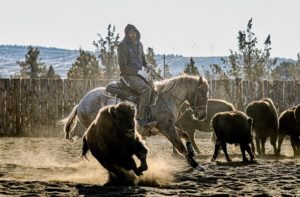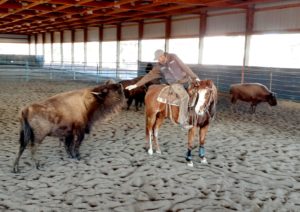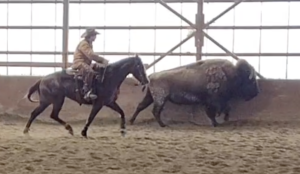
Shane Steffen working buffalo out of a herd
Is the expense and difficulty of sourcing cattle getting to be too much for you? Some reined cow horse trainers are branching out and working buffalo instead.
Shane Steffen, 2021 World’s Greatest Horseman Champion based in Powell Butte, Oregon, started using buffalo out of necessity eight years ago. Finding cows to work became difficult during the summer when local ranches didn’t have grass.
He knew cutters used buffalo and his neighbor happened to have a herd. After getting advice from his neighbor and accessing their buffalo, he knew he was onto a winner. He now has a lease agreement that includes feeding them in return for working them. He can also exchange them every year.
“They are a lot different than cows. You can actually train them and get them to do what you want, to an extent,” said Steffen.
RCHTO member Chet Martin runs his own training program in Canada and uses bison as well. Martin keeps three bulls on his place and rotates them out. He also has a lease deal with his neighbors. He started using buffalo because of difficulty sourcing cattle. The first set he bought were partially trained and he worked them for two years.
Steffen and Martin have developed their own methods for training buffalo that accomplish the same goal. They both keep at least one trained buffalo to help train the new buffalo. Steffen has been using the one featured in his RCHTO video for three years. She didn’t grow very much and she is still good to work, he said.
Martin said he too uses one buffalo that he’s had for five years! He added that he works it slower, but that’s fine for the young horses. This year, Steffen has a herd of 12 bison. He has worked bulls and heifers and hasn’t noticed a huge difference between them. Martin has a smaller cow horse program of six to eight horses and keeps three buffalo. Martin has always had bulls and can switch them out regularly with the breeder.
While buffalo are a huge part of these programs, Steffen and Martin will still work cows before big shows. There is a difference in the way cows and buffalo work and the horses need to be familiar with how a cow moves.
“Buffalo are a lot quicker and they don’t push into you like a cow will. I like to put the horses on cows a couple weeks prior [to a show], just to let them feel a difference,” Steffen said.
One year, Steffen had the opportunity to work cows almost exclusively and he noticed a difference in his horses. He and his wife realized it was because his horses didn’t experience the same speed down the fence on cows because bison are faster and have more endurance.
“I like using the buffalo. They’re a good training tool just because they don’t wear out. They’re pretty consistent on how you’re able to work. They allow your
horses to get comfortable at speed where a cow will wear out and slow down on you. A buffalo will continue to keep going,” he said.
He can work two to three horses on one buffalo each day. However he can only work a cow six to seven times total. While bison are more cost efficient than cattle, there is a learning curve to handling them. It’s important to have someone experienced with buffalo to advise you. While many people develop their own programs, there are a few basic musts when using bison.
When the wild buffalo first arrive at Steffen’s ranch, he puts them in a small pen by the arena. These pens help make sure that they won’t run at the fences. They are very intelligent animals and once they realize they can do something, it’s very difficult to change their mind, he said.
He then puts them in the arena as a group and lets them settle in. The older, trained buffalo come in handy because they know where to go to get the pressure released.
“When they first come in the arena, I just ride around them so they settle in the middle and I can lope around them and they aren’t completely taking off. [I] make sure they find the center of the arena the first few times. If I do work them [in the first days] if one goes off by itself, I’ll let it run around the outside until it actually stops and then I’ll bring it back to me and let him back into the group,” Steffen said.
“Once I get ready to work them, I take a horse and I trot and lope through them and scatter the herd just to get them used to me pushing through them. Until they start slowing down on their own.”

Steffen with a buffalo
Steffen and Martin said it takes one to two months to fully train the buffalo and maybe a little longer to get them used to going down the fence. They become very good at around 3-4 months, Martin said. To prepare to go down the fence with them, Steffen will bring them in separately and push them around.
“Buffalo are kind of like horses. Everyone is an individual so you have to think about each one and if they aren’t doing what you wan
Some are easier than others. Steffen said they’ll think about facing you and stopping and finding that release while others just want to run. You have to adapt the way you handle each one, as they have their own temperament and tendencies. It’s important to remember that you are training horses and buffalo. So the buffalo will need to be reminded where they are supposed to be.
When switching between events, Steffen said the key is “getting them used to you being that close [when you’re] going down the fence.”
He adjusts his works so that the horses that don’t need to be up close and tight to the bison in the beginning. Gradually the buffalo slows down and honors the horse. Then, he progressively moves closer as he gets horses worked. “I work in closer and closer to that one buffalo until he kind of accepts me. And once I feel like he’s accepting me in close and honoring me versus trying to outrun me then I will quit that buffalo that day and bring in a different one.”
Martin said he is careful with how he releases them. He never turns and walks away from one. He makes sure the buffalo is moving away from him. Unless it is a wild and flighty buffalo, then he will release it when it turns to him. Steffen said that if you have experience with cattle and training horses, bison might work for you. When working buffalo, the horse needs to quit in a good spot but so does the buffalo. You may need to work that buffalo on one more horse to make sure it finishes well.
 “I’ll try to think about getting that buffalo to slow down and face me or doing what I want and actually training that buffalo and quitting him when he’s doing what I want him to do,” Steffen said.
“I’ll try to think about getting that buffalo to slow down and face me or doing what I want and actually training that buffalo and quitting him when he’s doing what I want him to do,” Steffen said.
“[If you’ve never] had them before, think of them as an animal you can train and can learn, be taught and be patterned versus just a cow that you’re just going to work and they do what they’re going to do.”
Martin said, “They’re very different in how they respond to pressure,” and they have a bigger flight zone.
“I’ll never chase one out of the arena. I try to always make sure that they go to a spot away from the [gate] and I’ll open the [gate] and step away and let them find their way back out,” Martin said.
“To me, I go by the look in their eye. If they have a big soft eye they’re going to be good. And you can see, as time goes by, and they start to get more sour you can see the look in their eye change. They start to get a hard eye and then you better start watching them a little closer. [Looking at the eye] has been consistently like that for me.”
He said they don’t have as much ‘read’ as a cow does so it is still important to use cows in his program. He said the bison will stop and turn very suddenly with no hint they are going to make a move.
“I’ve had some [horses] spook at [buffalo] every time the [buffalo] makes a turn. It took their confidence a little bit because they couldn’t get a read on it. That’s why it’s pretty important to start off with a slower one and not get them going too fast too early on [buffalo],” Martin said.
Steffen said, “If you’re inexperienced on cattle and buffalo, and you’re wanting to get [buffalo] I would encourage you to get some that are already trained.”
Watch Shane’s Video on RCHTO Here!
Brought to you by Laredo Ranch PEMF Therapy
